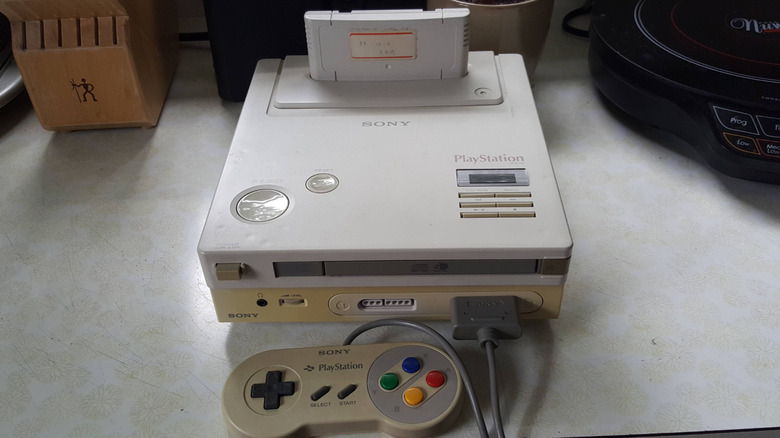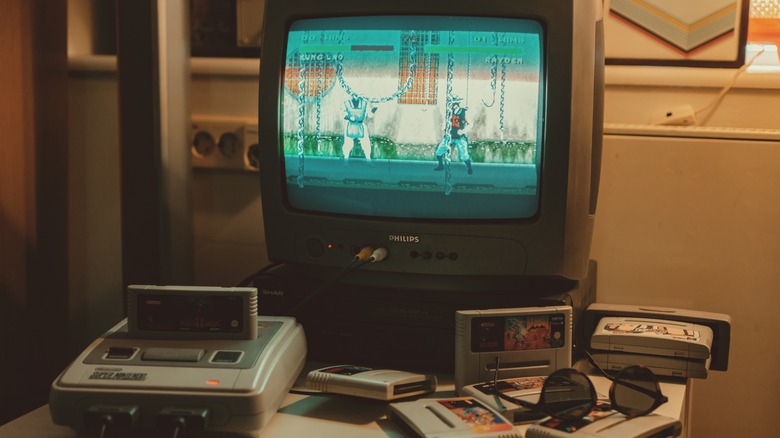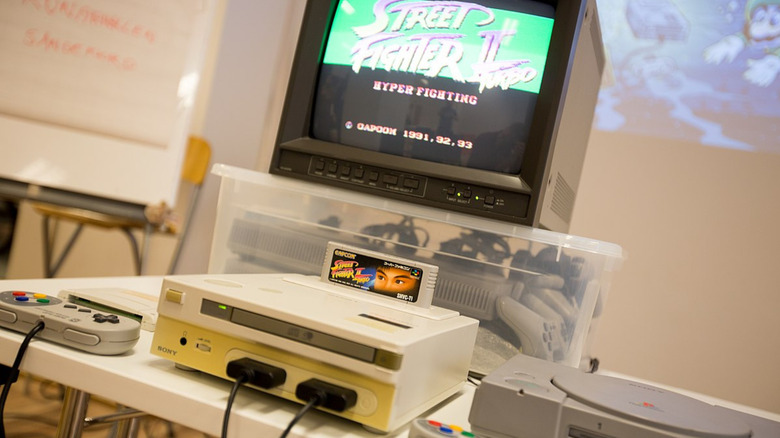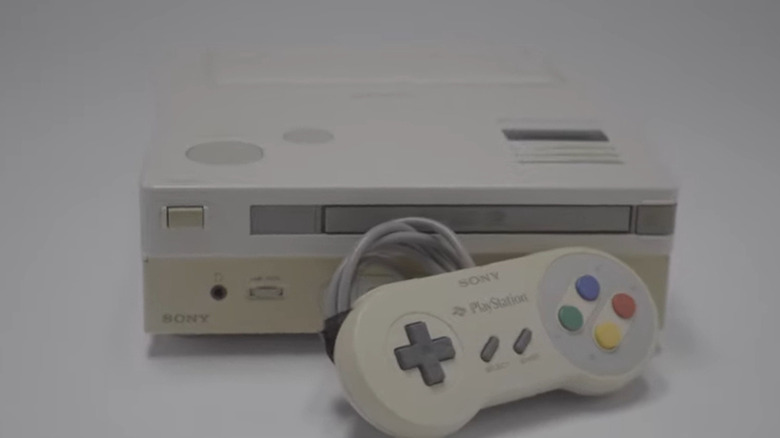The Wild History Of This Rare PlayStation Prototype
The PlayStation has become one of the most successful gaming brands in history and for good reason. Its CD-ROM capabilities back in its first iteration changed everything for the gaming industry and with each new version, they manage to find new ways to push graphical or storage boundaries. As such, it's no wonder that the PlayStation 5 has sold more than 38.4 million units since its launch in 2020, according to Sony.
However, there was a time when the PlayStation could have been very different from the console we know it as today. Sony's first big foray into gaming was originally never meant to be a standalone console — rather, it was supposed to be a collaboration with none other than their biggest current-day competitor, Nintendo. The Super NES CD-ROM, appropriately nicknamed "the Nintendo PlayStation" by gaming history enthusiasts, was supposed to be an add-on for the famous Super Nintendo Entertainment System. Think of it as similar to Sega's CD add-on for the Sega Genesis.
As one may surmise, however, things between Sony and Nintendo went sour fast. However, they didn't sour in the ways you might have expected, and its legacy was one that was doubted up until a few years ago.
The beginning of Sony and Nintendo's collaborative relationship
The legend, as recounted by Kotaku, goes that former Sony engineer and executive Ken Kutaragi was interested in exploring the world of gaming upon the release of Nintendo's Famicom system. Negotiations began for a collaboration between Sony and Nintendo to allow the former to produce a sound chip for the then-in-development SNES, which ended up working out. If you've ever enjoyed the sounds of a SNES game, you can thank Sony.
It made sense for the two companies to continue working together. Since the SNES was a smashing success and the rise of the CD-ROM was around the corner, it only made sense for them to explore the burgeoning medium. According to former Sony Computer Entertainment Head Shigeo Maruyama, it was Kutaragi who was interested in exploring CD-ROM compatibility with the SNES.
"He was a strong advocate for pursuing CD-ROM support over cartridges," the executive told the Japanese gaming website Denfaminicogamer. Nintendo Everything cross-posted and translated the interview into English.
The important thing to recognize is that while Sony was expressing interest in exploring the CD-ROM, Nintendo was not. According to Maruyama's interview with Denfaminicogamer, Nintendo reluctantly provided Kutaragi and Sony with the funding to make a CD-based add-on for the SNES. The tentative name for this add-on? The PlayStation.
Backstabbing changes the gaming industry forever
Given how Nintendo was allegedly not entirely on board with the idea of CD gaming, it shouldn't be a surprise that its partnership with Sony fizzled out. However, Sony continued work on the add-on in earnest, hoping to finally break into the hardware business after forming the publisher Sony Imagesoft in 1989. Ken Kutaragi and the rest of the company likely hoped to have the product officially revealed during the Summer 1991 Consumer Electronics Show.
However, according to "Game Over" author David Sheff, some Sony executives were told only 48 hours before the pivotal conference that Nintendo pulled the plug on the add-on. Instead of forgoing CD-ROMs altogether, though, they were now partnering with Philips for the same device. While attempts to stop the news from going public allegedly occurred, this betrayal eventually spurred Sony to act fast, announcing its add-on as an upcoming console during its own event at the conference.
And so, the rivalry between Nintendo consoles and the PlayStation was born. While Sony never got to make their CD add-on, neither did Philips — much like it did with Sony, Nintendo pulled out of its deal with the company at the last minute. Philips also decided to make their own console like Sony, although its CD-i device is much less fondly remembered today. One might presume that's where the story ends, as SlashGear's Chris Gates did back in 2015. However, it was only the beginning.
From unreleased flop to collector's item
One of the main reasons why the add-on's cancelation came as a shock to Sony was because it had around 200 different prototypes already created, according to ArsTechnica. It isn't clear what became of these prototypes, but the general consensus was that they were likely all destroyed.
All, seemingly, except one. In 2015, Reddit user analogueboy revealed to the r/Gaming subreddit that his father still owned a prototype of the Super NES CD-ROM, posting photos and explaining that it was a gift from a friend of the family. Four years and one restoration later, Kotaku interviewed the Reddit user's father, Terry Diebold, who said that after getting several appraisals from all over the world, they decided to put the prototype up for auction.
When it did go up for auction in 2020, an intense bidding war ensued almost immediately. It ultimately became a battle between Pets.com founder Greg McLemore and Oculus VR co-founder Palmer Luckey, with McLemore winning with a $300,000 bid. Considering the rarity of the product and its importance in video game history, this was hardly a surprise. If the wheels of fate turned ever so slightly, who can say what would have happened to the video game industry? The possibilities are endless and likely scary, but thankfully, we live in the best timeline.



